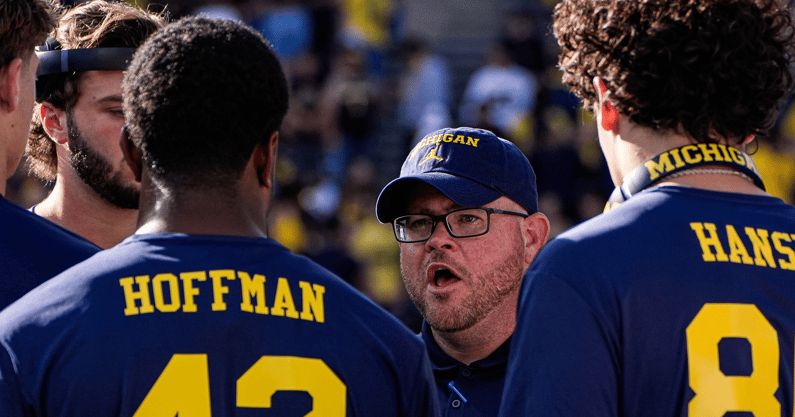Steve Casula on Michigan tight end usage: 'They have [already] had a huge role'

Michigan had perhaps the best tight end in the country last year in Colston Loveland, the Wolverines’ top receiver and a top 10 NFL Draft pick after his outstanding season. There was hope someone would follow in his footsteps this year and emerge as an alpha receiver, but injuries and inconsistency have prevented the group from putting up big receiving numbers.
Michigan tight ends coach and co-offensive coordinator Steve Casula understands when asked why they haven’t been as much a factor in the passing game this year. At the same time, he’s quick to point out that they’re involved in just about everything the offense does.
“The tight ends have had a huge role,” the Michigan assistant said Wednesday. “And I get it. I do, because … you look at a box score or a stat sheet, and it’s a production position. So, so much is relative or relevant to how many catches or targets that we have. We played collectively as a group on offense. We played five guys [in a win over Northwestern], and I believe they totaled over 130 snaps. So, I don’t know how our role could get bigger.”
Last year, Casula noted, Loveland set the Michigan single-season record for catches in a season position, but the Wolverines ranked 130th in the country in total offense. They’ve risen 90 spots to 40th, and while the tight ends haven’t caught as many balls, they’ve been extremely important when it comes to blocking, catching a big pass on occasion, and opening things up for the other position groups.
“If you asked myself or any one of our tight ends what they would prefer, they would prefer 8-2 and 420 yards a game, 10 out of 10 times,” he said. “… We’ve gotten accustomed to here to the tight end being up there [on the stat sheet]. But they couldn’t have a bigger role. They’re so critical to our pass protection, our run game. We’re playing in 12 personnel on third down, and just not every game and not every year is the same.
“But we do make an effort to have them critically involved and intimately involved in the pass game. That’s a big part of Coach [Michigan offensive coordinator Chip] Lindsey’s background. Obviously, that’s Coach [Sherrone] Moore’s starting point background, and it’s a big part of my background … and they are involved. They’re critically, critically, critically involved in the pass game.”
There will be games where his group catches six passes for 93 yards, others three for 38, he added. Against Northwestern there were four catches in a 24-22 Michigan win, and “two were for critical third-down conversions, I believe, on scoring drives,” Casula said.
Top 10
- 1
Bowl projections
Michigan vs. SEC???
- 2
CFP rankings
Where Michigan ranks
- 3
Basketball nuggets
Thoughts on Michigan hoops
- 4
Revisiting preseason goals
One down, many to go for Michigan
- 5
Andrew Marsh
Talks MONSTER performance
Get the Daily On3 Newsletter in your inbox every morning
By clicking "Subscribe to Newsletter", I agree to On3's Privacy Notice, Terms, and use of my personal information described therein.
“You look at the box score, and it’s easy. It’s a production position, and you want to evaluate performance based upon that,” he reiterated. “A huge part of what we do is running routes and catching the ball.
“But the most important things we do, to be quite honest, probably aren’t that, and that’s not to diminish that part of the game. It’s a huge part of our game here. It’s a huge part of our history. Coming into this season, the tight ends at Michigan, not including 2020, had caught more passes than any team in the country since 2015.”
It’s the core of what the offense is, Casula said. At the same time, one thing will always be more important, and the tight ends have played a big factor in it this year.
“We’re about winning, and we’re about growth,” Casula said. “And that’s what we’ve done as an offense.”